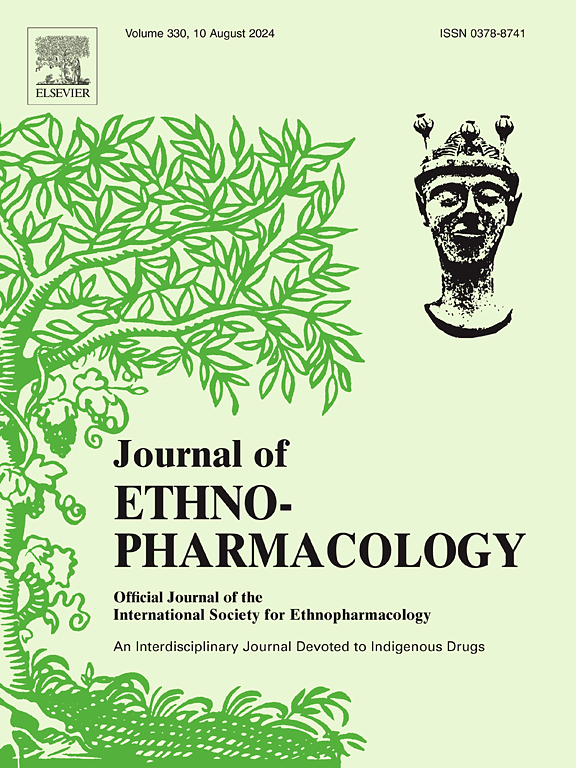Molecular mechanisms of Potentilla Discolor Bunge in regulating ferroptosis to alleviate DKD via the Nrf2 signaling pathway
IF 4.8
2区 医学
Q1 CHEMISTRY, MEDICINAL
引用次数: 0
Abstract
Ethnopharmacological relevance
Potentilla Discolor Bunge (PDB), a plant belonging to the Rosaceae family, is often used in traditional folk medicine to treat diabetes and prevent related complications. Additionally, fresh and tender PDB stems could be consumed as a vegetable or used to make tea.
Aim of the study
To explore the potential targets and mechanisms of PDB in treating Diabetic Kidney Disease (DKD) through network pharmacology, and to investigate its role in modulating the Nrf2 signaling pathway to inhibit ferroptosis using in vivo and in vitro experiments, thereby presenting a potential therapeutic avenue for DKD.
Materials and methods
Targets of PDB compounds were screened using the Traditional Chinese Medicine Systems Pharmacology (TCMSP) database, while PDB action targets were screened using the DrugBank, OMIM, GeneCards, DisGeNET, and TTD databases. The intersecting targets were subjected to Gene Ontology (GO) and Kyoto Encyclopedia of Genes and Genomes (KEGG) enrichment analyses. Meanwhile, the binding modes of PDB core monomers to key targets were analyzed using Molecular Docking (MD) and Surface Plasmon Resonance (SPR) experiments. Experimental validation was conducted using a High-Fat/Sucrose Diet (HFD) combined with Streptozotocin (STZ)-induced DKD rat model and an Advanced Glycation End Products (AGEs)-damaged human renal proximal tubular cell (HK-2) model.
Results
As predicted through network pharmacology, PDB exerted therapeutic effects against DKD through multiple pathways, including AGE/RAGE, Nrf2 signaling, Oxidative Stress, and apoptosis. Furthermore, PDB's primary active constituents were Quercetin, Kaempferol, and β-sitosterol, with MD analyses suggesting strong binding affinities to the Nrf2 and Ho-1 proteins. In vivo experiments further revealed that PDB treatment reduced the 24 h urinary protein, Serum Creatinine (SCr), and urea levels. It also downregulated Malondialdehyde (MDA), Fe2+, and Reactive Oxygen Species (ROS) accumulation in renal tissues. Additionally, PDB alleviated the histopathological damage in DKD-afflicted rats and significantly upregulated Nrf2, Ho-1, Gpx4, and Slc7a11 in renal tissues. Moreover, Quercetin, Kaempferol, and β-sitosterol significantly upregulated Nrf2, Ho-1, and Gpx4, increased intracellular Glutathione (GSH) levels, reduced ROS and MDA content, and mitigated mitochondrial damage in the AGEs-exposed HK-2 cell injury model.
Conclusion
We predicted the mechanism of action of natural botanical PDB against DKD through network pharmacology, revealing that it significantly upregulated the Nrf2 signaling pathway and inhibited ferroptosis initiation, thus decelerating DKD progression. These findings were further validated through in vivo and in vitro experiments.
翻白草通过Nrf2信号通路调控铁下垂缓解DKD的分子机制
民族药理学意义:紫菀属蔷薇科植物,在传统民间医学中常用于治疗糖尿病和预防相关并发症。此外,新鲜嫩的PDB茎可以作为蔬菜食用或用来泡茶。研究目的:通过网络药理学探索PDB治疗糖尿病肾病(DKD)的潜在靶点和机制,并通过体内和体外实验研究PDB通过调节Nrf2信号通路抑制铁沉的作用,从而为DKD的治疗提供一条可能的途径。材料和方法:利用中药系统药理学(Traditional Chinese Medicine Systems Pharmacology, TCMSP)数据库筛选PDB化合物的靶点,利用DrugBank、OMIM、GeneCards、DisGeNET和TTD数据库筛选PDB作用靶点。对交叉目标进行基因本体(GO)和京都基因与基因组百科全书(KEGG)富集分析。同时,利用分子对接(MD)和表面等离子体共振(SPR)实验分析了PDB核心单体与关键靶点的结合模式。采用高脂肪/蔗糖饮食(HFD)联合链脲佐菌素(STZ)诱导的DKD大鼠模型和晚期糖基化终产物(AGEs)损伤的人肾近端小管细胞(HK-2)模型进行实验验证。结果:正如网络药理学预测的那样,PDB通过AGE/RAGE、Nrf2信号、氧化应激和细胞凋亡等多种途径发挥对DKD的治疗作用。此外,PDB的主要活性成分是槲皮素、山奈酚和β-谷甾醇,MD分析表明PDB与Nrf2和Ho-1蛋白有很强的结合亲和力。体内实验进一步表明,PDB处理降低了24小时尿蛋白、血清肌酐(SCr)和尿素水平。它还下调丙二醛(MDA)、铁离子(Fe2+)和活性氧(ROS)在肾组织中的积累。此外,PDB还能减轻dkd大鼠的组织病理损伤,并显著上调肾组织中Nrf2、Ho-1、Gpx4和Slc7a11的表达。此外,槲皮素、山奈酚和β-谷甾醇显著上调Nrf2、Ho-1和Gpx4,增加细胞内谷胱甘肽(GSH)水平,降低ROS和MDA含量,减轻ages暴露的HK-2细胞损伤模型中的线粒体损伤。结论:我们通过网络药理学预测了天然植物PDB对DKD的作用机制,发现其可显著上调Nrf2信号通路,抑制铁下垂的发生,从而减缓DKD的进展。这些发现通过体内和体外实验得到了进一步的验证。
本文章由计算机程序翻译,如有差异,请以英文原文为准。
求助全文
约1分钟内获得全文
求助全文
来源期刊

Journal of ethnopharmacology
医学-全科医学与补充医学
CiteScore
10.30
自引率
5.60%
发文量
967
审稿时长
77 days
期刊介绍:
The Journal of Ethnopharmacology is dedicated to the exchange of information and understandings about people''s use of plants, fungi, animals, microorganisms and minerals and their biological and pharmacological effects based on the principles established through international conventions. Early people confronted with illness and disease, discovered a wealth of useful therapeutic agents in the plant and animal kingdoms. The empirical knowledge of these medicinal substances and their toxic potential was passed on by oral tradition and sometimes recorded in herbals and other texts on materia medica. Many valuable drugs of today (e.g., atropine, ephedrine, tubocurarine, digoxin, reserpine) came into use through the study of indigenous remedies. Chemists continue to use plant-derived drugs (e.g., morphine, taxol, physostigmine, quinidine, emetine) as prototypes in their attempts to develop more effective and less toxic medicinals.
 求助内容:
求助内容: 应助结果提醒方式:
应助结果提醒方式:


